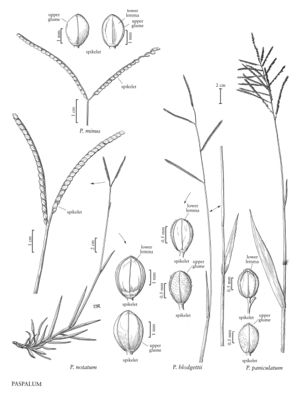Paspalum minus
Plants perennial; shortly rhizomatous. Culms 3-60 cm, erect; nodes glabrous. Sheaths glabrous or pubescent; ligules 0.2-0.7 mm; blades 8-18 cm long, 2-7.1 mm wide, flat, glabrous or pubescent. Panicles terminal, usually composed of a digitate pair of branches, a third branch sometimes present below the terminal pair; branches 1.8-6.4 cm, diverging to erect; branch axes 0.5-1.3 mm wide, narrowly winged, glabrous, margins scabrous, terminating in a spikelet. Spikelets 1.9-2.3 mm long, 1.2-2 mm wide, solitary, appressed to the branch axes, broadly elliptic to ovate to obovate, glabrous, stramineous, apices obtuse. Lower glumes absent; upper glumes 3-veined, lower lemmas faintly 3-veined; upper florets stramineous. Caryopses 1.8-2.2 mm, white. 2n = 20, 40, 50.
Distribution
Puerto Rico, Tex., La., Ala., Miss., Fla.
Discussion
Paspalum minus grows in disturbed areas and on the edges of forests. It grows from southern Texas to Florida in the Flora region; outside the region, it extends through Mexico and the West Indies to Peru, Bolivia, Brazil, and Paraguay.
Selected References
None.
